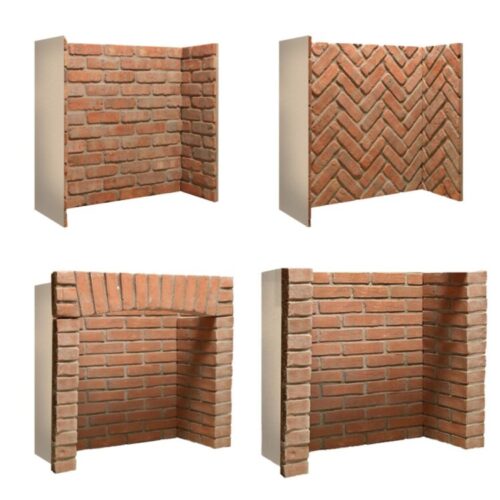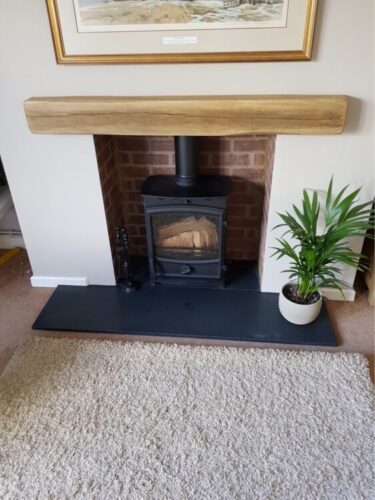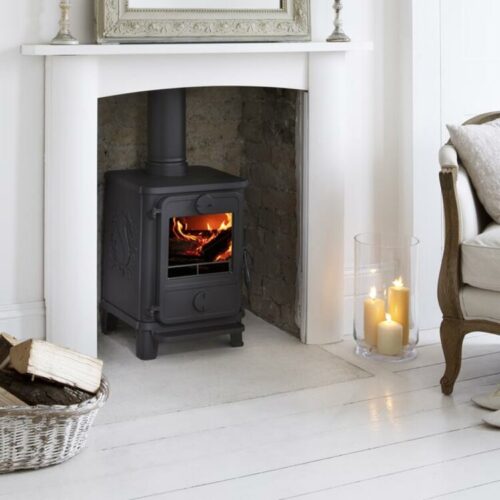Many homeowners consider installing a wood stove in their existing fireplace as a way to enhance both the aesthetic appeal and heating efficiency of their homes. However, this process involves careful consideration of various factors to ensure safety and compliance with building codes. In this article, we’ll explore the key aspects to know before installing a wood burner in a fireplace.
What to Know Before Installing Wood burner in a Fireplace (in an Existing Fireplace):
Chimney and Flue Size:
One of the critical considerations is ensuring that your existing chimney and flue are compatible with a wood-burning stove. The size of the flue must meet the requirements for proper draft and ventilation. In some cases, a stainless steel liner may be necessary to bring the flue to the appropriate dimensions.
Distance to Combustibles:
Maintaining proper clearances to combustible materials is crucial for safety. Check the manufacturer’s guidelines for the specific wood stove you plan to install. Keep in mind that the required clearances can vary depending on factors such as stove design and local building codes.
StoveHeat Output:
Matching the heat output of the wood stove to the size of the room is essential. Installing an overly powerful stove may lead to overheating, while an insufficiently powerful stove may not provide adequate warmth. Consider factors like insulation, room size, and climate when selecting a wood stove.
Ventilation:
Adequate ventilation is necessary to ensure proper combustion and to avoid the buildup of harmful gases like carbon monoxide. Consult local building codes to determine the ventilation requirements for wood-burning stoves. In some cases, additional air vents may need to be installed to provide sufficient airflow.
Stove Hearth and Surround:
The area around the wood stove, known as the hearth, must comply with safety standards. This includes the type of material used, size, and clearance from the stove. Additionally, a non-combustible surround may be required to protect nearby walls from heat.
Remember also about regulations which telling us that hearths that reach up to 100°C should:
- Increase the dimensions by a minimum of 300mm forward and 150mm on each side of the stove.
- Ensure the designated space is no smaller than 840 x 840mm.
- Maintain a thickness of at least 12mm.
- Craft the extension using non-combustible materials.

Can You Open Up an Old Fireplace For a Wood Burner?
In some cases, it is possible to convert an old, unused fireplace into a suitable space for a wood-burning stove. This process involves assessing the structural integrity of the fireplace, ensuring proper clearances, and addressing any necessary modifications to accommodate the stove.
Before embarking on the installation of a wood-burning stove in an existing fireplace, it’s crucial to consider factors such as chimney and flue size, distance to combustibles, stove heat output, ventilation, stove hearth, and the possibility of opening up an old fireplace. Adhering to these considerations will not only enhance the safety of the installation but also contribute to the overall efficiency and functionality of the wood-burning stove.
Table summarizing key considerations for Installing your Wood burner in a Fireplace:
| Consideration | Key Points |
|---|---|
| Chimney and Flue Size | Check compatibility; consider stainless steel liner |
| Distance to Combustibles | Adhere to clearances; comply with local codes |
| Stove Heat Output | Match to room size; consider insulation |
| Ventilation | Ensure proper airflow; comply with local codes |
| Stove Hearth and Surround | Follow safety standards for materials and clearance |
| Open Up an Old Fireplace | Assess structural integrity; address modifications |
FAQ: Installing a Wood burner in a Fireplace
-
Can I install a Wood burner in a Fireplace (in my existing fireplace)?
- Yes, it is possible to install a wood stove in an existing fireplace. However, several factors need consideration to ensure safety and compliance with regulations.
-
Do I need to modify my chimney or flue for the installation?
- It depends on the compatibility of your existing chimney and flue. In some cases, a stainless steel liner may be required to meet the appropriate dimensions for proper draft and ventilation.
-
What clearances should I maintain to combustible materials?
- Clearances vary based on factors like stove design and local building codes. Always refer to the manufacturer’s guidelines for specific clearances and ensure compliance with local regulations.
-
How do I determine the appropriate heat output for my wood stove?
- Consider factors such as room size, insulation, and climate. Choosing a stove with an output that matches your needs ensures both efficiency and comfort.
-
Are additional ventilation requirements necessary?
- Adequate ventilation is crucial for proper combustion and to prevent the buildup of harmful gases. Consult local building codes to determine if additional air vents are needed to meet ventilation requirements.
-
What materials are suitable for the stove hearth and surround?
- The hearth must be made of non-combustible materials, and the surround should comply with safety standards. Always adhere to guidelines regarding size and clearance to protect nearby walls from heat.
-
Can I convert an old fireplace for a wood burner?
- Yes, it’s possible to convert an old, unused fireplace for a wood-burning stove. Ensure the structural integrity of the fireplace, address necessary modifications, and comply with safety standards during the conversion process.
-
Do I need professional help for the installation?
- While some experienced homeowners may choose to install a wood stove themselves, it’s advisable to seek professional help, especially for complex installations. A certified installer can ensure compliance with safety standards and local building codes.
-
What are the potential benefits of installing a wood-burning stove?
- Benefits may include increased heating efficiency, reduced energy costs, and the aesthetic appeal of a wood-burning stove. However, it’s crucial to weigh these benefits against the costs and considerations involved in the installation process.
-
How can I ensure the safety of my wood-burning stove installation?
- Prioritize safety by following manufacturer guidelines, adhering to local building codes, and consulting with professionals. Regular maintenance and inspections also contribute to the safe and efficient operation of your wood-burning stove.


